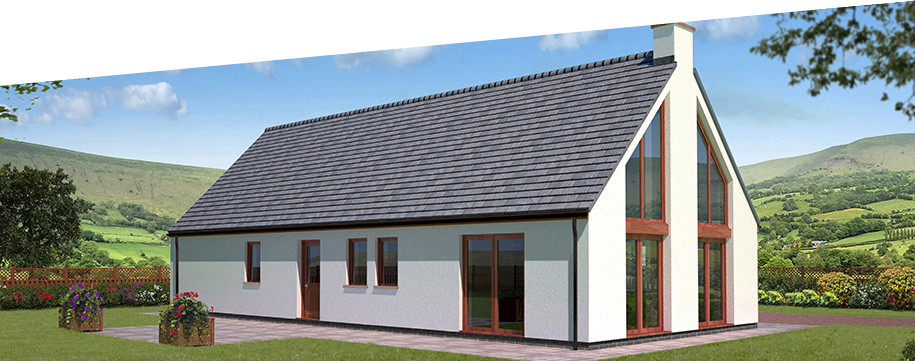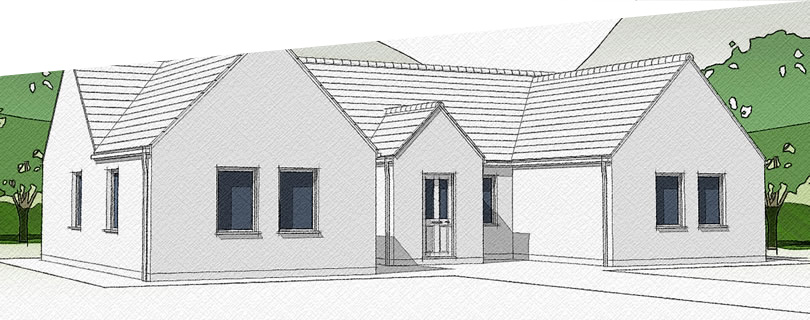
Frequently Asked Questions
Do You Have Any Show Homes To View?
No, we do not. To be candid, show homes only offer any value if it’s the house type you’re actually looking for. For the most part they are little more than an interior design exercise.
Of greater importance is the actual construction and the benefits that offers to the home owner in terms of cost and energy efficiency. The internal features can be whatever you want them to be.
Although we offer ‘standard’ designs and a ‘standard’ specification the concept behind Cottage Kit Homes is very flexible and every cottage focuses on customer requirements.
Our website includes a virtual tour through one of our Cottage Kit Homes and will, hopefully, give you a sense of the environment we aim to achieve with Cottage Kit Homes.
Do I Need To Employ An Architect?
No, we have our own in-house design team, led by a qualified architect.
We provide all necessary drawings, specification, SAP calculations and kit / truss structural certificates.
Whether you choose a standard kit (with or without alteration) or require a bespoke cottage to your own design, this service is provided free of charge.
Unless you are local to us you will need to employ a local surveyor to provide us with site specific information such as dimensions, boundary details, ground levels and service arrangements.
As part of our service we will also seek planning consent and building regulation approval, on your behalf . You will only be required to pay the necessary statutory fees to the local authority.
Do You Offer A Turnkey Service?
No, we do not. The reason for this is simply a matter of cost and management – by the time we’ve added in travel and subsistence costs it would be very expensive and managing a project at arm’s length is rarely satisfactory. Frankly, any kit manufacturer (unless they are within say 50 miles of you) will struggle to provide this service cost effectively or efficiently. And, if they do, there are almost certainly going to be delays and co-ordination issues.
By far and away the best option is for you to appoint a trusted local builder to undertake the work, with the kit manufacturer simply supplying the kit. A local builder will know the ground conditions (necessary when designing foundations) in your area, avoiding any costly surprises. They will have a good working relationship with the local building control officers, ensuring your project runs smoothly. And, they will know the best sub-contractors to employ for specialist trades such as plumbing, heating and electrical works.
The kit erection should not offer any kind of a challenge to the builder. We supply full working drawings and an erection manual which provide all necessary information. Exceptionally, we can provide a structural kit erection service (to wind and watertight stage) but, again, travel and subsistence costs weigh heavily into the overall cost of this service.
Do You Offer A Kit Erection Service?
We do have an erection team but by the time we add in travel and subsistence costs our erection service is unlikely to be very competitive. So, we tend to confine this service to ‘local’ projects, within 50 miles of our base.
Travel and subsistence costs will also be an issue for any so called ‘specialist’ timber frame erection service, unless they are local to your project. In any event, in our opinion. this type of service is probably unnecessary and simply creates another team of workers to be managed.
Most kit erection services are limited to simply erecting the structural kit components to wind and watertight stage. This is because they can get in and out in one visit and not have multiple visits working around electrical and plumbing first fix.
Unless you are able / willing to do the internal fitting out (lay flooring; erect internal partitions; fit insulation, plasterboard and skirtings; fit internal window sill boards, door sets and architraves; (possibly) fit kitchen) yourself, you will be employing either a joiner or a builder who undertakes joinery work.
There is no reason why whoever is going to undertake the internal fitting out could not undertake the erection. We supply a comprehensive erection manual and for a competent joiner it should be quite straightforward. This way you save travel and subsistence costs which are arguably an unnecessary added expense.
This said, we have had customers throughout the UK and as far afield as France who wanted total peace of mind. They reasoned that if having designed and manufactured their kit, we also erected it, we alone were responsible for the structural integrity of their new home. Whilst this is undoubtedly true, it comes at a price!
Do I Need To Use An NHBC Registered Builder?
No, you do not. We would recommend you do, if you are looking for a single contractor to undertake a full build service. As the leading home warranty and insurance provider and standards-setter for UK house-building, NHBC’s ‘Buildmark’ covers around 80% of new homes built in the UK and currently protects over 1.6 million homes. And, you will need a ‘warranty’ for mortgage purposes.
If you plan to either undertake most of the work yourself or project manage a number of separate trades, the ‘Buildmark’ route will not be an option. As an alternative, the NHBC offer a ‘Solo’ policy designed specifically to tackle the particular risks of self building. It’s exclusively for people who plan to build (or contract a builder not registered with NHBC to build) a home for their own occupation.
It’s available for new homes up to a maximum of 400m² and building work must be started within one year of the date they accept your application and completed within two years of the date your foundations are concreted. But, this is not for the feint hearted and a good understanding of building construction is a pre-requisite.
By far the simpler route is to appoint a suitable qualified, independent, building supervisor who will provide the Professional Consultants Certificate required by the Council of Mortgage Lenders. If you go down this route, the builder does not need to be NHBC and any claims for defects would be made against the consultant’s professional indemnity insurance.
Open or Closed (SIP) Wall Panels?
All Cottage Kit Homes wall panels are pre-fabricated, ready for installation on site, by others.
As standard the wall panels are supplied with open framing, clad on the outside with 9 mm Orientated Strand Board (OSB). Once erected on site the panels are infilled with insulation and finished internally. Whilst this requires a bit more work on site, the panels are lighter and easier to man handle.
As an option we can supply closed wall panels, also known as SIPs (Structural Insulated Panels). In this case the panels arrive on site with the insulation installed and also clad on the inside with 9mm OSB. Whilst this speeds up construction on site the panels are much heavier and will require mechanical handling. There is also an additional cost.
Is it Possible To Render Directly Onto Your Kit Panels?
It is possible to apply traditional render directly onto the wall panels using battens and expanded metal lath (see NHBC guidance note). There are also what are called monocouche render systems which would work with our EcoWall Plus option. However, you need to bear in mind that any timber structure will be subject to some movement, due to timber being a natural material.
Whilst this is more of a consideration the further north you are, we would recommend a render finish be applied to an outer skin of blockwork. Alternatively, you could have a facing brick outer skin (without render), depending on your preference and subject to any planning requirements.
What's Not Included In Your Kit Package?
The Cottage Kit Homes package is one of the most comprehensive in the marketplace and essentially includes all joinery components and materials.
To be clear the following are not included in our timber frame kit packages:
- Foundations and walls to dpc level.
- Concrete floor slab and underfloor insulation.
- Kit erection (unless quoted separately).
- Outer wall around kit (if applicable).
- Roof tiles/slates and dry ridge/verge.
- Rainwater gutters and downpipes.
- Kitchen units and appliances.
- Sanitary ware and plumbing materials.
- Heating equipment and materials.
- Electrical equipment and materials.
- Ventilation equipment and materials.
- Floor and wall tiling and the like.
- Painting & decorating materials.
However, please note, the costs generated by our Build Cost Calculator do include everything. Our Project Cost Sheet will help you identify the additional costs you need to consider.
Other questions?
If you have a question which isn’t answered here, you can contact us and we’ll be happy to help.


